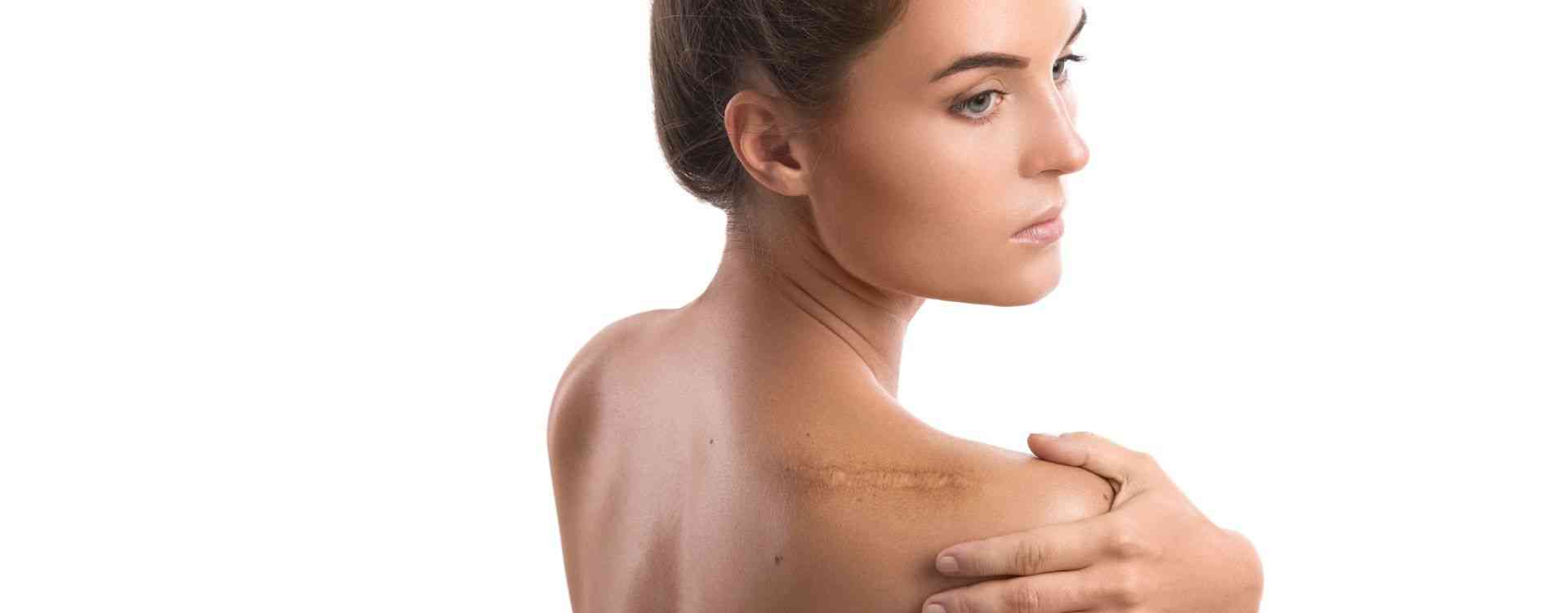Menu
Scarring: Causes and treatment
Injuries, surgery, burns, and scalds can cause scars on anywhere on your body, which can understandably affect self-confidence, as scar tissue can be unsightly.
Introduction to Scarring
Where tissue has been damaged, the body produces collagen over the course of around 3 months to help mend the area, which causes the wound to become raised and red as part of the healing process. After this time, it starts to break down again, and you are left with the smooth, soft, or pale section of skin that is known as a scar.
At PHI Clinic, we have a range of treatments like laser resurfacing that can reduce the appearance of scar tissue. For more information on the best scar treatment for you, book a no obligation appointment with one of our highly trained clinicians.
Introduction to Scarring
Where tissue has been damaged, the body produces collagen over the course of around 3 months to help mend the area, which causes the wound to become raised and red as part of the healing process. After this time, it starts to break down again, and you are left with the smooth, soft, or pale section of skin that is known as a scar.
At PHI Clinic, we have a range of treatments like laser resurfacing that can reduce the appearance of scar tissue. For more information on the best scar treatment for you, book a no obligation appointment with one of our highly trained clinicians.
Scarring transformations
PHI Clinic review
Scar treatment prices
Types of scars
Five main types of scars have been identified, that are caused by a certain kind of damage to the tissue and appear differently on the skin.
Flat/pale Scars these are initially red and dark but settle into pale, flat lines or marks over around 2 years
Hypertrophic scars these are red or raised scars that can stay red for years, still appearing dark when healed
Keloid scars, keloid scars happen when excess scar tissue is produced at the site of the wound even after the wound has healed, growing beyond the area in a raised fashion
Atrophic (pitted/ice pick) scars these have a sunken appearance and are commonly caused by acne or chicken pox, where structures under the skin are damaged and skin reacts to changes below
Contracture scars commonly referred to as burn scars, these are cause by the skin shrinking and tightening, which can restrict movement at the site
Types of scars
Five main types of scars have been identified, that are caused by a certain kind of damage to the tissue and appear differently on the skin.
Flat/pale Scars these are initially red and dark but settle into pale, flat lines or marks over around 2 years
Hypertrophic scars these are red or raised scars that can stay red for years, still appearing dark when healed
Keloid scars, keloid scars happen when excess scar tissue is produced at the site of the wound even after the wound has healed, growing beyond the area in a raised fashion
Atrophic (pitted/ice pick) scars these have a sunken appearance and are commonly caused by acne or chicken pox, where structures under the skin are damaged and skin reacts to changes below
Contracture scars commonly referred to as burn scars, these are cause by the skin shrinking and tightening, which can restrict movement at the site
Laser resurfacing to treat scars
Fractional laser resurfacing has emerged as a highly effective scar treatment, offering numerous benefits. Firstly, it promotes skin rejuvenation by stimulating collagen production, resulting in smoother and healthier-looking skin. The precision of laser technology allows for targeted treatment, minimizing damage to surrounding tissues. Additionally, laser resurfacing is a non-surgical treatment, requiring little to no downtime compared to surgical alternatives.
Fractional laser resurfacing can effectively reduce the appearance of various scars, including acne scars, surgical scars, and stretch marks. With customisable settings, it offers flexibility to address different scar types and depths. Overall, laser resurfacing provides a safe and efficient solution, restoring confidence and improving skin texture for individuals with scars.
Laser resurfacing to treat scars
Fractional laser resurfacing has emerged as a highly effective scar treatment, offering numerous benefits. Firstly, it promotes skin rejuvenation by stimulating collagen production, resulting in smoother and healthier-looking skin. The precision of laser technology allows for targeted treatment, minimizing damage to surrounding tissues. Additionally, laser resurfacing is a non-surgical treatment, requiring little to no downtime compared to surgical alternatives.
Fractional laser resurfacing can effectively reduce the appearance of various scars, including acne scars, surgical scars, and stretch marks. With customisable settings, it offers flexibility to address different scar types and depths. Overall, laser resurfacing provides a safe and efficient solution, restoring confidence and improving skin texture for individuals with scars.
Safe and effective treatment
Your safety is our top priority and making our patients feel welcomed and reassured when entering PHI Clinic. To ensure maximum standard of patient care, all of our treatments are only ever carried out by our experienced and highly qualified team, who receive regular in-house and external training from industry experts.
At PHI Clinic we do not offer same day treatment as initial consultation to ensure patients have time to reflect on their bespoke treatment plan before choosing to proceed.
Scarring treatment frequently asked questions
Location
PHI Clinic
102 Harley Street,
London,
W1G 7JB,
United Kingdom
Tel: +44 7883 317963
Opening Hours
Monday & Tuesday - 9:30am to 6:00pm
Wednesday & Thursday - 9:30am to 8:00pm
Friday - 9:30am to 5:30pm
Saturday & Sunday - Closed
Opening times can change, if your appointment is outside of these times please contact the clinic for confirmation.


